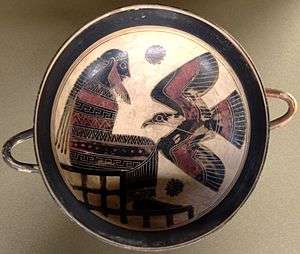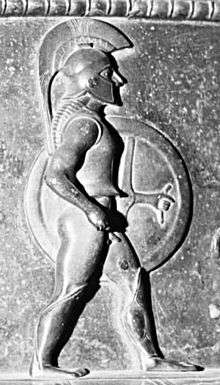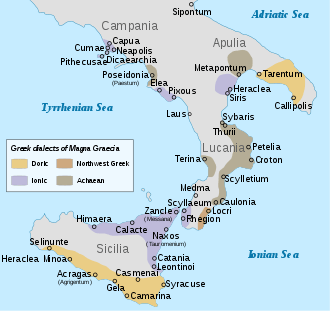List of kings of Sparta
This List of Kings of Sparta details the important rulers of the ancient Greek city-state of Sparta in the Peloponnese.
| Sparta |
 Zeus on his throne with his eagle This article is part of the series: |
| Great Rhetra Laws of Lycurgus Politeia |
|---|
| List of Kings of Sparta Gerousia Ephorate Apella Spartiates Perioeci Helots Agoge Syssitia |
|
Spartan army • Other Greek city-states • Law Portal |
Sparta was unusual among the Greek city-states in that it maintained its kingship past the Archaic age. It was even more unusual in that it had two kings simultaneously, who were called the archagetai,[1][n 1] coming from two separate lines. According to tradition, the two lines, the Agiads and Eurypontids, were respectively descended from the twins Eurysthenes and Procles, the descendants of Heracles who supposedly conquered Sparta two generations after the Trojan War. The dynasties themselves, however, were named after the twins' grandsons, the kings Agis I and Eurypon, respectively. The Agiad line was regarded as being senior to the Eurypontid line.[3]
Although there are lists of the earlier purported Kings of Sparta, there is little evidence for the existence of any kings before the middle of the sixth century BC or so.
Spartan kings received a recurring posthumous hero cult like that of the Doric kings of Cyrene.[4] The kings' firstborn sons, as heirs apparent, were the only Spartan boys expressly exempt from the Agoge; however, they were allowed to take part if they so wished, and this endowed them with increased prestige when they ascended the throne.
Legendary kings
Ancient Greeks named males after their fathers, producing a patronymic with the infix -id-; for example, the sons of Atreus were the Atreids. For royal houses, the patronymic was formed from the name of the founder or of an early significant figure of a dynasty. A ruling family might thus have a number of dynastic names; for example, Agis I named the Agiads, but he was a Heraclid and so were his descendants.
If the descent was not known or was scantily known, the Greeks made a few standard assumptions based on their cultural ideology. Agiad people were treated as a tribe, presumed to have descended from an ancestor bearing its name. He must have been a king, who founded a dynasty of his name. That mythologizing extended even to place names. They were presumed to have been named after kings and divinities. Kings often became divinities, in their religion.
Lelegids
The Lelegid were the descendants of Lelex (a back-formation), ancestor of the Leleges, a Pelasgian tribe inhabiting the Eurotas valley before the Greeks, who, according to the mythological descent, amalgamated with the Greeks.
| Year | Lelegid | Other notable information |
|---|---|---|
| c. 1600 BC | Lelex | son of Poseidon or Helios, or he was said to be autochthonous |
| c. 1575 BC | Myles | son of Lelex |
| c. 1550 BC | Eurotas | son of Myles, father of Sparta |
Lacedaemonids
The Lacedaemonids contain Greeks from the age of legend, now treated as being the Bronze Age in Greece. In the language of mythologic descent, the kingship passed from the Leleges to the Greeks.
| Year | Lacedaemonid | Other notable information |
|---|---|---|
| c. | Lacedaemon | son of Zeus, husband of Sparta |
| c. | Amyklas | son of Lacedaemon. He founded Amyklai |
| c. | Argalus | son of Amyklas |
| c. | Kynortas | son of Amyklas |
| c. | Perieres | son of Kynortas |
| c. | Oibalos | son of Kynortas |
| c. | Tyndareos | (First reign); son of Oibalos and father of Helen |
| c. | Hippocoon | son of Oibalos and brother of Tyndareos |
| c. | Tyndareos | (Second reign) |
- Years with no dates (only "c.") are unknown
Atreids
The Atreidai (Latin Atreidae) belong to the Late Bronze Age, or the Mycenaean Period. In mythology, they were the Perseides. As the name of Atreus is attested in Hittite documents, this dynasty may well be protohistoric.
| Year | Atreid | Other notable information |
|---|---|---|
| c. 1250 BC | Menelaus | son of Atreus and husband of Helen |
| c. 1150's BC | Orestes | son of Agamemnon and nephew of Menelaus |
| c. | Tisamenos | son of Orestes |
| c. 1100 BC | Dion | husband of Iphitea, the daughter of Prognaus |
- Years with no dates (only "c.") are unknown
Heraclids
The Spartan kings as Heracleidae claimed descent from Heracles, who through his mother was descended from Perseus. Disallowed the Peloponnesus, Hercules embarked on a life of wandering. The Heracleidae became ascendant in the Eurotas valley with the Dorians who, at least in legend, entered it during an invasion called the Return of the Heracleidae; driving out the Atreids and at least some of the Mycenaean population.

| Year | Heraclid | Other notable information |
|---|---|---|
| c. | Aristodemos | son of Aristomachus and husband of Argeia |
| c. | Theras (regent) | son of Autesion and brother of Aristodemus's wife Argeia;[n 2] served as regent for his nephews, Eurysthenes and Procles. |
- Years with no dates (only "c.") are unknown
Agiad dynasty
The dynasty was named after its second king, Agis.
| Year | Agiad | Other notable information |
|---|---|---|
| c. 930 BC | Eurysthenes | Return of the Heracleidae |
| c. 930 – 900 BC[n 3] | Agis I | Subjugated the Helots |
| c. 900 – 870 BC | Echestratus | Expelled the Cynurensians[n 4] that were in power. |
| c. 870 – 840 BC | Labotas[n 5] | |
| c. 840 – 820 BC | Doryssus | |
| c. 820 – 790 BC | Agesilaus I | |
| c. 790 – 760 BC | Archelaus | |
| c. 760 – 740 BC | Teleclus | Killed by the Messenians |
| c. 740 – 700 BC | Alcamenes | First Messenian War begins |
| c. 700 – 665 BC | Polydorus | First Messenian War ends; killed by the Spartan nobleman Polemarchus[5] |
| c. 665 – 640 BC | Eurycrates | |
| c. 640 – 615 BC | Anaxander | |
| c. 615 – 590 BC | Eurycratides | |
| c. 590 – 560 BC | Leon | |
| c. 560 – 520 BC | Anaxandridas II | Battle of the Fetters |
| c. 520 – 490 BC | Cleomenes I | Greco-Persian Wars begins |
| c. 490 – 480 BC | Leonidas I | Battle of Thermopylae |
| c. 480 – 459 BC | Pleistarchus | First Peloponnesian War begins |
| c. 459 – 445 BC, 426 – 409 BC | Pleistoanax | Second Peloponnesian War begins |
| c. 445 – 426 BC, 409 – 395 BC | Pausanias | Helped restore democracy in Athens; Spartan hegemony |
| c. 395 – 380 BC | Agesipolis I | Corinthian War begins |
| c. 380 – 371 BC | Cleombrotus I | |
| c. 371 – 369 BC | Agesipolis II[n 6] | |
| c. 369 – 309 BC | Cleomenes II | Third Sacred War begins |
| c. 309 – 265 BC | Areus I | Killed in battle against Aristodemus, the tyrant of Megalopolis |
| c. 265 – 262 BC | Acrotatus II | |
| c. 262 – 254 BC | Areus II[6] | |
| c. 254 – 242 BC | Leonidas II | Briefly deposed while in exile avoiding trial |
| c. 242 – 241 BC | Cleombrotus II | |
| c. 241 – 235 BC | Leonidas II | |
| c. 235 – 222 BC | Cleomenes III | Exiled after the Battle of Sellasia |
| Following the Battle of Sellasia, the dual monarchy remained vacant until Cleomenes III's death in 219. | ||
| c. 219 – 215 BC | Agesipolis III | last Agiad, deposed by the Eurypontid Lycurgus |
Eurypontid dynasty
The dynasty is named after its third king Eurypon. Not shown is Lycurgus, the lawgiver, a younger son of the Eurypontids, who served a brief regency either for the infant Charilaus (780–750 BC) or for Labotas (870–840 BC) the Agiad.
| Year | Eurypontid | Other notable information |
|---|---|---|
| c. 930 BC | Procles | Return of the Heracleidae |
| c. 890 BC | Soos | Son of Procles and father of Eurypon. |
| c. 890 – 860 BC | Eurypon | |
| c. 860 – 830 BC | Prytanis | |
| c. 830 – 800 BC | Polydectes | |
| c. 800 – 780 BC | Eunomus | |
| c. 780 – 750 BC | Charilaus | Ward and nephew of the Spartan reformer Lycurgus; War with the Argives; destroyed the border-town of Aegys; Battle of Tegea. |
| c. 750 – 725 BC | Nicander | |
| c. 725 – 675 BC | Theopompus | First Messenian War |
|
According to Herodotus, VIII: 131
|
According to Pausanias, III, 7: 5-6
|
| Year | Eurypontid | Other notable information |
|---|---|---|
| c. 575 – 550 BC | Agasicles | Contemporary with Leon |
| c. 550 – 515 BC | Ariston | Battle of the Fetters. |
| c. 515 – 491 BC | Demaratus | deposed |
| c. 491 – 469 BC | Leotychidas II | great grandson of Hippocratidas, Greco-Persian Wars |
| c. 469 – 427 BC | Archidamus II | Second Peloponnesian War begins |
| c. 427 – 401 BC[n 7] | Agis II | Spartan hegemony; Attacked Epidaurus, Leuctra,[n 8] Caryae, Orchomenos, and Mantineia; Invaded the Argolis; Council of war[n 9] formed to check his powers. |
| c. 401[n 7] – 360 BC | Agesilaus II | Corinthian War begins |
| c. 360 – 338 BC | Archidamus III | Third Sacred War begins |
| c. 338 – 331 BC | Agis III | |
| c. 331 – 305 BC | Eudamidas I | |
| c. 305 – 275 BC | Archidamus IV | |
| c. 275 – 245 BC | Eudamidas II | |
| c. 245 – 241 BC | Agis IV | |
| c. 241 – 228 BC | Eudamidas III | |
| c. 228 – 227 BC | Archidamus V | |
| c. 227 – 222 BC | Eucleidas | Actually an Agiad; installed by Cleomenes III[n 10] in place of Archidamus V. Died in the Battle of Sellasia. |
| Following the Battle of Sellasia, the dual monarchy remained vacant until Cleomenes III's death in 219. | ||
| c. 219 – 210 BC | Lycurgus | deposes the Agiad Agesipolis III and ruled alone |
| c. 210 – 206 BC | Pelops | son of Lycurgus |
Sole kings
| Year | Tyrants | Other notable information |
|---|---|---|
| c. 210–207 BC | Machanidas | regent for Pelops |
| c. 206–192 BC | Nabis | first regent for Pelops, then usurper, claiming descent from the Eurypontid king Demaratus |
| c. 192 BC | Laconicus | last known king of Sparta from Heraclid dynasty |
The Achaean League annexed Sparta in 192 BC.
Notes and references
- Notes
- Greek: ἀρχᾱγέται, archagétai, plural of ἀρχᾱγέτης, arkhāgétēs, Doric Greek form of Attic ἀρχηγέτης, arkhēgétēs.[2]
- A Cadmid of Theban descent.
- According to Apollodorus of Athens.
- Cynuria is said to have been colonized by Cynurus; Cynurensian bandits were common in the lands.
- Or Labotes, Leobotes.
- Agesilaus II, distinguished king of Sparta, being asked which was the greater virtue, valor or justice, replied: "Unsupported by justice, valor is good for nothing; and if all men were just, there would be no need of valor".
- Or 427 – 400 BC.
- And again, after the Carnean festival.
- Consisting of 10 Spartans.
- I.e. Eucleidas's brother.
- References
- Hall, Jonathan M. (2007). A History of the Archaic Greek World: Ca. 1200-479 BCE. John Wiley & Sons. p. 129. ISBN 978-0-631-22668-0.
- ἀρχᾱγέτας, ἀρχηγέτης. Liddell, Henry George; Scott, Robert; A Greek–English Lexicon at the Perseus Project.
- Cartledge, Paul, The Spartans, Vintage Books, 2003.
- Pindar and the cult of heroes. By Bruno Currie Page 245 ISBN 0-19-927724-9.
- A Classical Dictionary By John Lemprière. Pg 618.
- A Prosopography of Lacedaemonians, Part 396. By Alfred S. Bradford. Page 44.
Further reading
- The Cyclopædia, Volume 20. By Abraham Rees. Page 157+ (List of kings of Sparta on pg. 164).
- Sir William Smith, A New Classical Dictionary of Greek and Roman Biography, Mythology, and Geography: Partly Based Upon the Dictionary of Greek and Roman Biography and Mythology. Harper & Brothers, 1851.
- Sir William Smith. Abaeus-Dysponteus. J. Murray, 1890.
- Sir William Smith. A Dictionary of Greek and Roman Biography and Mythology: Earinus-Nyx. J. Murray, 1876.
- William Smith (Ed.) A Dictionary of Greek and Roman Biography and Mythology: Oarses-Zygia. J. Murray, 1880.
External links
- Livius
- Eurypontids and Agiads by Jona Lendering

